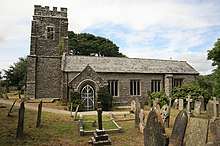St Cyricius and St Julietta's Church, St Veep
St Cyricius and St Julietta's Church, St Veep is a Grade I listed Church of England parish church in St Veep, Cornwall.[3]
| St Cyricius and St Julietta's Church, St Veep | |
|---|---|
 St Cyricius and St Julietta's Church, St Veep | |
| 50°21′55.4″N 4°37′0″W | |
| Location | St Veep Cornwall |
| Country | England |
| Denomination | Church of England |
| History | |
| Dedication | Cyricus and Julitta |
| Architecture | |
| Heritage designation | Grade I listed[1] |
| Administration | |
| Parish | St Veep |
| Deanery | Trigg Minor and Bodmin[2] |
| Archdeaconry | Bodmin |
| Diocese | Truro |
| Province | Canterbury |
History and description
The parish church was originally dedicated to Saint Veep, cruciform in design and in 1269 belonged to Montacute Priory.[3] Nothing remains of the church from this period
It was rebuilt in 1336 and rededicated to Saint Quiricus and Saint Julietta.[4] The west tower appears to date from this rebuilding, but the rest of the church is late 15th century or early 16th century. Dendrochronological dating suggests c. 1460 for the nave and chancel roofs, but as late as 1540 for the north aisle roof.
Following the Prayer Book Rebellion of 1549, a number of well-known Cornish figures and priests were murdered or hanged in Cornwall. These included Richard Bennet, vicar of St Veep, under the direct orders of Anthony Kingston, Provost Marshal serving under King Edward VI.[5]
Valuable church silverware, which had been deposited with Lloyds Bank of St Austell and subsequently lost, was rediscovered in 2015 at a storage facility near Glasgow. Items included a communion cup (dated 1579), silver flagon tankard (1737) and a silver plate (1738).[6]
Parish status
The church is in a joint benefice with:
- St Brevita’s Church, Lanlivery
- St Winnow’s Church, St Winnow
- Boconnoc Church
- St Mary the Virgin's Church, Braddock
- St Nectan's Chapel, St Winnow
- St Bartholomew's Church, Lostwithiel
Monuments
- Nicholas Courtney (d. 1589)
Organ
The organ has a pipe organ which was extensively rebuilt by J.W. Walker and Sons in 1871. A specification of the organ can be found in the National Pipe Organ Register.[7]
Bells
The tower contains a peal of 6 bells all dating from 1770 by Pennington and Company.[8] These were all cast in the churchyard and are the only known example in England of a Virgin Peal, in that they came out of the cast perfectly tuned.[3]
References
- Historic England. "Church of St Ciricus and Julitta (Grade I) (1140311)". National Heritage List for England. Retrieved 11 May 2019.
- "St Veep (St Cyrius and St Julitta)". A Church Near You. The Church of England. Retrieved 15 May 2019.
- Beacham, Peter; Pevsner, Nikolaus (2014). The Buildings of England. Cornwall. Yale University Press. p. 605. ISBN 9780300126686.
- "Lake's parochial history of Cornwall - St Veep" (PDF). Retrieved 19 June 2011.
- Philip Payton - (1996) "Cornwall", Fowey: Alexander Associates
- Barton, Lyn (3 December 2015). "Cornish Church's historic 'lost' silverware found in Scottish aircraft hangar". Western Morning News. p. 3. Retrieved 4 December 2015.
- "NPOR C00865". National Pipe Organ Register. British Institute of Organ Studies. Retrieved 15 May 2019.
- "St Veep S Quiricus & S Julietta". Dove's Guide for Church Bell Ringers. Dovemaster. 13 June 2018. Retrieved 13 May 2019.